 |
|
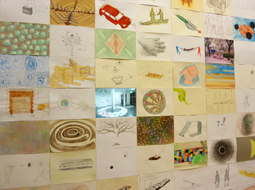 |
| Moment: Performative Hills (2011) is the latest in Yukihiro Taguchi's Moment series of performative installations now on display at the Mori Art Museum. The name is a playful nod to the fact that every Mori Building project includes "Hills" in its name. |
|
Uber (2009): a montage of video and over 500 sketches. |
Yukihiro Taguchi is an emerging artist originally from Osaka and now based in Berlin. His first solo exhibition in Japan, MAM Project 014, can be seen in Gallery One of the Mori Art Museum with access to the main exhibition, French Window. While studying oil painting at the prestigious Tokyo University of the Arts, Taguchi became more interested in performance art and installation. He developed what he calls "performative installations" -- work whose form changes over time. Manipulating everyday objects such as furniture and cast-off building materials and photographing each change, he produces stop-motion animations by assembling a series of the still images. These are then displayed in temporarily constructed exhibits that utilize the space and provide a fluid connection to the visitor, who becomes directly or indirectly part of the process. His videos are playful, as fun to watch as they appear fun to participate in.
MAM Project 014 includes a work commissioned especially for the current exhibition entitled Moment: Performative Hills. In this piece wooden wall panels from the gallery appear to march out of the museum and take a journey into the greater world, engaging in many encounters along the way. Taguchi's supporting drawings, static installations and footage of his earlier works are also on display. The Moment series began in Berlin in 2007 with a work called Moment: Performatives Spazieren. Originally he intended to lift up the existing floorboards of a gallery and reassemble them into a new piece within the space. As Taguchi flipped through the photos he had taken to document his process, he saw the potential of stitching them back together as an animation, thereby giving life to otherwise inanimate objects.
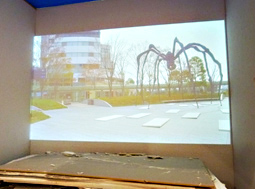 |
|
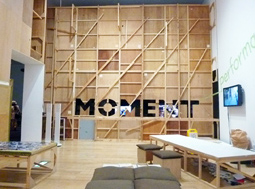 |
| Moment: Performative Hills (2011): wall panels removed from the MAM gallery appear to have come to life as they march out of the museum and into the world. |
|
The name of Taguchi's series, "moment," suggests the fleeting nature of his performance work, which reflects life as an accumulation of experiences. |
The Mori Art Museum's concurrent exhibition, French Window, features past winners of France's coveted Marcel Duchamp Prize for contemporary art. Duchamp, who was most closely associated with the Dadaists and Surrealists of the early 20th century, challenged notions of what constitutes art and the artistic process. Through his "readymade" approach, he famously turned a urinal into art simply by titling it Fountain. Showing Taguchi's work in tandem with that of the Marcel Duchamp Prize winners seems a fitting juxtaposition, as he too exploits found objects for both his static and performative installations. Taguchi's art is also reminiscent of the time-based compositions of American performance artist John Cage during the 1950s and '60s and the Happenings movement of Cage's contemporary, Allan Kaprow. The viewer does not need to have had any exposure to these earlier movements, however, to appreciate Taguchi's work.
Taguchi himself doesn't often appear on film; he acts as choreographer and director of the performance and editor of the resulting stop-motion video. It is evident from his detailed sketches that a great deal of planning goes into each of his installations. There is also an element of improvisation that he welcomes into the process. In many cases the piece comes out very much like the sketches, but in other cases it does not, for example when it rains or there is a crowd of people that he didn't expect. In an interview, Taguchi says that "in such a creative process, it is more important to consider how to incorporate these situations with the work that you are trying to create, or alternatively how to deal with these situations as you create your work."
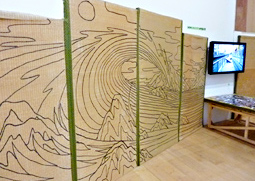 |
|
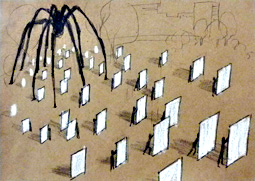 |
| Moment: Tatami (2011) includes a video revealing how his performative installations are made. |
|
One of many planning sketches made in preparation for Moment: Performative Hills (2011). At times Taguchi's performances unfold as planned but in other cases, when the weather or the public does not cooperate, creative improvisation is needed. |
By setting up a framework of rules while leaving ample room for contingency, Taguchi's performances appear to occur naturally in their setting. Passersby may look on with interest or interact, but for the most part they just go about their business. A subtle engagement with the public in the environment seems to be what motivates Taguchi's work rather than a subversive statement in the vein of Cage or Duchamp. Perhaps Taguchi wants to skirt the rules, written or unwritten, but not break them outright. Some of his performances do likely require guerilla tactics, however. One is reminded of the infamous Shibuya Crossing scene in Sophia Coppola's 2003 film Lost in Translation, where she had her cameraman sneak into a nearby coffee shop that offered a perfect vantage point to film from. Coppola wisely knew that were she to pursue all of the proper approvals, she might still be waiting to make that film.
In seeing what we have all imagined at one point or another being realized, visitors are deeply engaged and delighted by Taguchi's performative installations. In the exhibition booklet, Mami Kataoka, chief curator of the Mori Art Museum notes, "Judging by the frequency with which it appears in both fairy tales and contemporary movies such as Toy Story, I think we can say that the fantasy in which toys come to life in the middle of the night is shared by all of us at some level of our consciousness." A more direct sense of connectedness is achieved by the two Tokyo-based installations on display -- Moment: Tatami and Moment: Performative Hills -- particularly the latter, because everyone who visits the show has just wandered up through the Roppongi Hills complex to get to the museum and recognizes the context. It is immediately familiar. Taguchi says that one thing he tries to reflect in his work is how the world is interconnected even though it may not seem to be: "That is why my work this time and my past work, as well as the relationship among people, are a chain-reaction accumulation comprising absolutely all things."
 |
|
A video clip of Yukihiro Taguchi's work can be seen here.
Remnants of the white wood panels that were stripped from the Mori Art Museum gallery walls and temporarily brought to life in Moment: Performative Hills (2011).
All photos by Nicolai Kruger with permission of the Mori Art Museum |
|